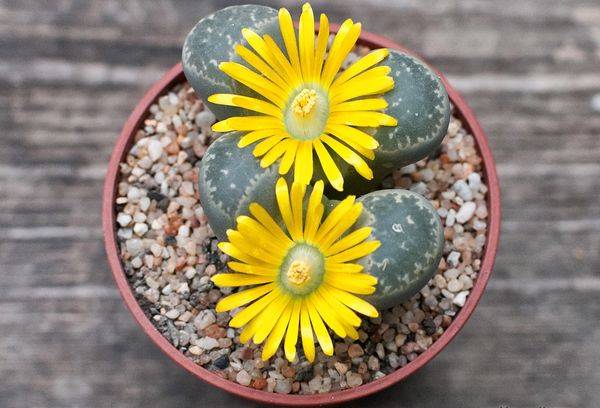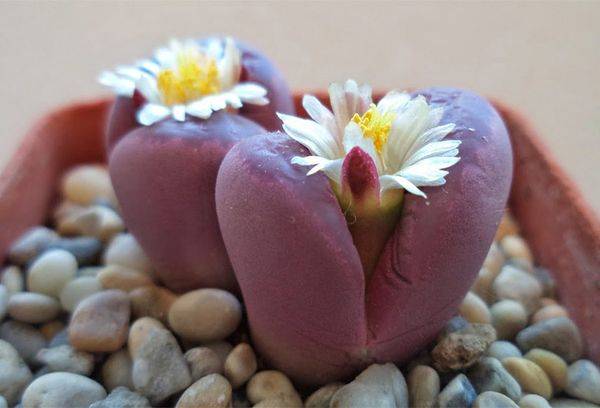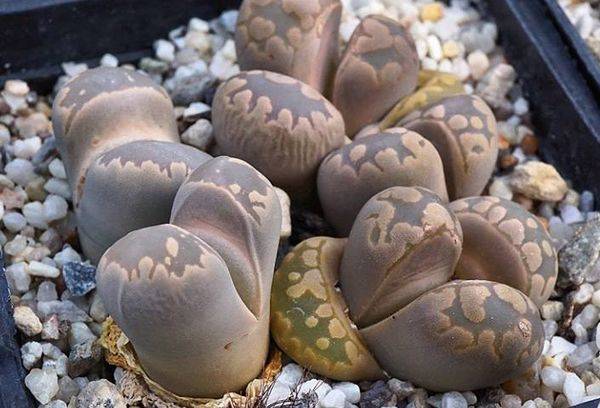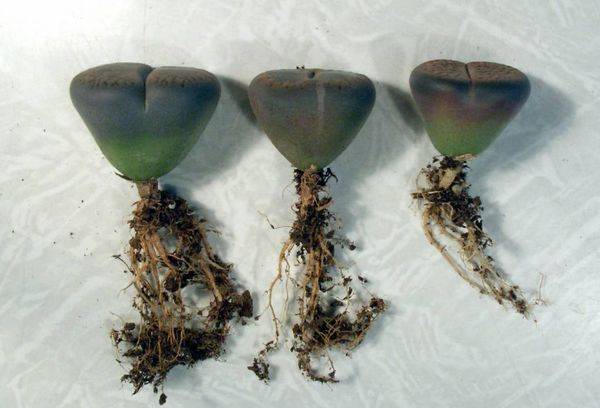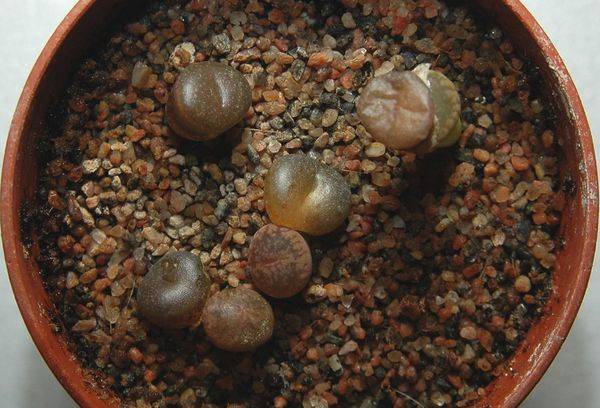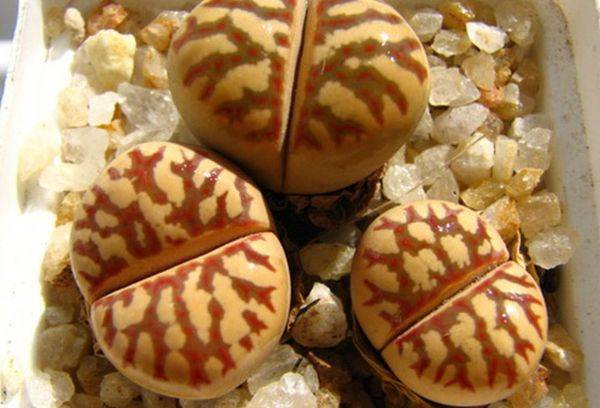Garden of living stones, or How to care for lithops
Content:
Many housewives choose lithops for its original appearance. They are like a real living stone. When they bloom, it is impossible to take their eyes off them. At the same time, care for lithops is minimal, they rather do not like excessive custody than they are afraid of inattention.
Description
Lithops (or Lithops) - succulent, originally from South Africa, more precisely, from the desert. This is precisely what caused the unusual appearance and habits of the plant. Its main feature is in the leaves. They are surprisingly thick and dense, from the side it seems as if only a stone lies on the road, but in fact it is paired leaves. On their surface are small hollows. Every year in the spring they are updated.
It is impossible to plant such flowers for the sake of beauty, paired leaves really look like dusty cobblestones. However, they are by far the most original and unusual of many plants.
Interesting fact
The appearance of lithops is due to camouflage. This is a way of self-defense, because no one will eat or tear stones in the desert.
By structure, the root system is of more interest. It is several times larger than the ground part. The uniqueness is that the roots go deep into the ground, but at the same time they are able to collect moisture from the surface. This is necessary for survival, because in the desert there is very little nutrition for plants.
Although all lithops resemble stones, it is difficult to call them the same. The color of the leaves varies from sandy to bluish, in addition, sometimes there are interesting patterns on the surface. Their depth of 2-3 mm allows you to get the maximum amount of sun and heat.
It is worth paying attention to the periods of growth of this flower. Every year, new leaves appear from old leaves. In no case should you delete last year's: they are the main source of nutrition. Old leaves are removed only after two empty peels remain instead of thick and fleshy leaves. By then, the new sprouts will already be strong.
Regarding the flowers here are still more interesting. At home, lithops bloom from August to October. They have a beautiful flowering. By evening, the petals usually close, but during the day, especially in the sun, they open again.
It is worth noting that lithops feel great in greenhouses or on balconies, the most important thing is to try to ensure an acceptable temperature and humidity.
Types of lithops
In room conditions, several varieties of living stones take root. Often, flower growers make up whole compositions of variegated lithops, and this rock garden amazes guests when it blooms amazingly beautiful flowers.
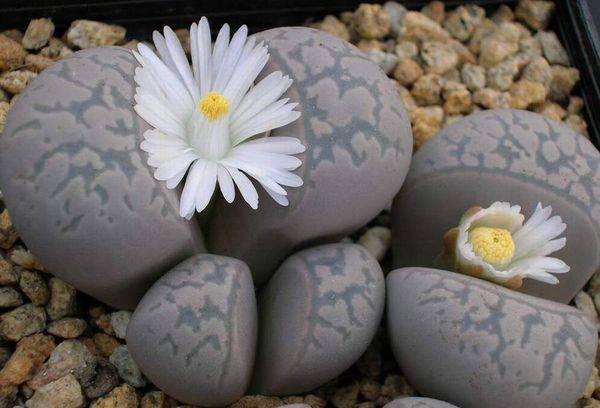
Lithops marble
The most famous species:
- Brownish. The main shade is beige-brown. There is even a semblance of rust on the flowers. The top of the leaf is greatly truncated. Slightly darker than the lines of the pattern, at the tips they are even brighter and look attractive, playing in contrast. Chic yellow flowers bloom, they are small in size, but look very harmonious with the leaves.
- Volka. Most similar lithops to large pebbles. It is grayish-green and has a pattern in the form of several small dots. In the central part of the gap, but it is not in the middle. In the future, it is from her that a flower appears that has a golden hue.
- Keglevidny. Fully lives up to its name and looks unusual. The leaves are stretched up and have a flat top, on it are dark patterns, voluminous tubercles. Large flowers, up to 4 cm in diameter, look amazingly beautiful. As a result, it seems as if the bud is much larger than the leaves.
- Nice. There is a large flower that seems to split a ball of leaves. The base color is olive, and the petals are most often white.
- Leslie. Perhaps the most original look in terms of coloring. Here the shades can vary from olive and chocolate to light green, yellowish. As a result, the leaves are a real work of art.
- Marble. Despite the fact that it looks rough, it is very smooth, as if polished. Light and dark gray shades are woven into an amazing pattern.
- False Truncated. The most romantic of this kind. It is grayish pink and is decorated with yellow or golden flowers. It looks very beautiful and original.
- Optics. It has bright purple colors. Usually they are very small and grow in groups. The flower petals are white and look extremely elegant.
- Aucamp. Almost holistic. The gap between the leaves is least visible on it. As a result, this is the most rounded version, and the flower petals erupt from the inside and it looks extremely impressive.
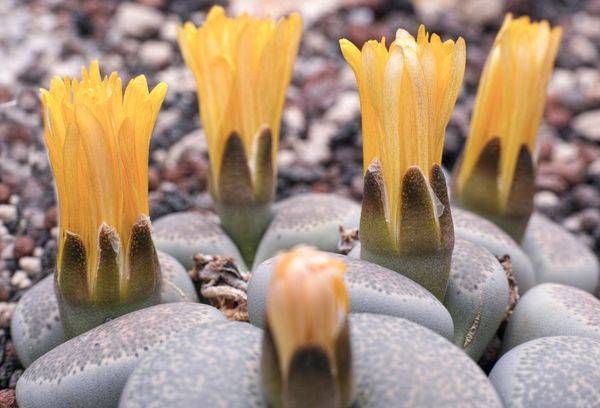
Lithops Leslie
General care recommendations
First of all, it must be borne in mind that succulents were brought from a rather arid and hot region. For the success of cultivation in the home, you need to try to repeat the natural conditions. There are several highlights:
- Flowers need sunshine. Necessarily light should fall directly on the pot.
- High temperatures. Even the most intense heat will not cause the flower to die. On the contrary, fear should be cold and drafts.
- Aridity. There should not be too much moisture. The plant accumulates water in its large fleshy leaves and for many days lives quietly without watering.
Tip
purityis.decorexpro.com/en/ magazine recommends paying attention to the fact that the plant needs active watering during flowering.
How to arrange a living rock garden so that every pebble feels at home?
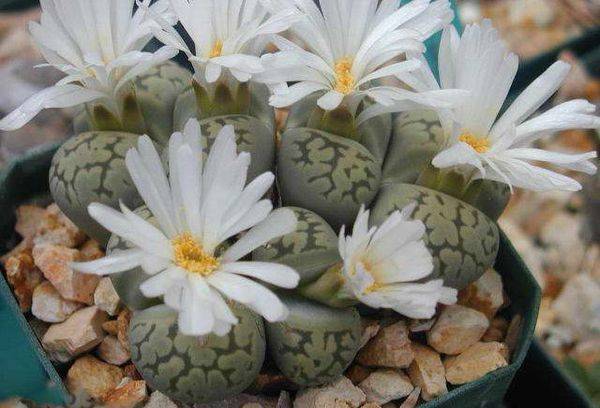
Lithops Beautiful
Lighting, watering
The care includes several activities. One of the key is watering. It should be rare enough. In addition, it is necessary that the water goes carefully under the bush and in no case fall on the leaves. A serious danger is rotting due to flooding.
The normal frequency of watering is once a month. During the flowering period, as already mentioned, the flower needs a little more water, but then you need to moisten the soil once every few days, allowing the soil to dry.
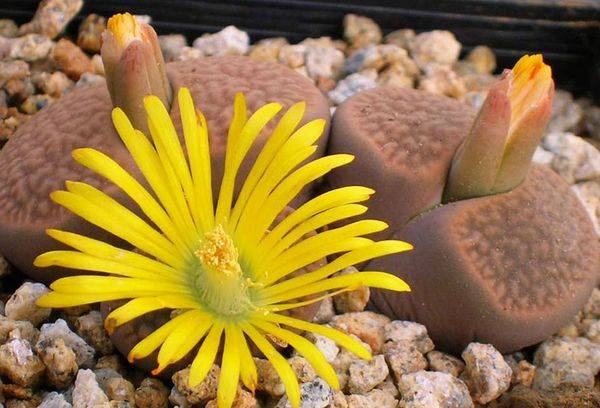
Scalloped lithops
Tip
These plants are extremely capricious about chemicals (growth stimulants, for example). It is better to abandon these drugs, in extreme cases - use on mature, already mature leaves.
The second important point in caring for lithops is lighting. The succulent adores bright light, if it is not enough, it begins to stretch and turn pale. In this case, rearrange the pot on the south window or closer to the binding. Another option is to turn on the phytolapma or fluorescent lamp.
Although lithops are extremely photophilous, sometimes the owners still overdo it with the rays. As a result, the leaves begin to turn red - this will be a bright signal that you need to reduce the light intensity. Rearrange the pot for a while in partial shade or shadow.
Planting and reproduction
As a rule, succulent leaves with a developed root system are acquired in stores. However, buying lithops is not necessary if the view you like flourishes with your friends. This genus of succulents is very prolific and tenacious. Ask to store seeds for you, you can grow them yourself and without difficulty, just take care of good lighting.
Choose a south window that is not obscured by trees or balconies. The composition of the soil is not fundamental: some growers prefer to introduce more sand, others take a universal soil mixture, others try to saturate the earth with mineral additives. In this matter, the plant is quite unpretentious. The ideal time for sowing is mid-summer.
Tip
If there is too little sun in the house or apartment, then the deficit is compensated by just the nutrients in the earth. Then the soil should consist of 60 percent of mineral additives.
Before planting, it is best to store the seeds in the fruit and tear it exclusively before sowing. The procedure algorithm is surprisingly simple:
- Seeds are separated from the remnants of the fetus.
- Sifted for complete cleaning, it is necessary for the prevention of mold.
- Fungicides can be used, but with great care and in small doses.
- The seeds spread out on the soil are watered with boiled water, and melt is also suitable.
- For several days, the pot is covered with glass, film or transparent plastic: for seedlings need high humidity and heat.
- The landing is ventilated periodically to avoid mold.
Seeds germinate after 2 weeks - watering is gradually reduced, care begins as an adult plant.
It makes sense to plant lithops in groups: such flowers look especially original when they form entire families. The composition from different types of succulents looks even more impressive. Get a beautiful and neat rock garden. When it blooms, not a single guest will remain indifferent.
Groups are formed immediately or gradually: the fruits are dried, the seeds are collected and planted for “adding to the family”. In any case, it is important to remember that over time, the lithops develop a very powerful root system, which requires a lot of space.
Tip
A good solution would be to immediately pick up a large, much larger flower pot in size for a succulent. Gradually, lithops fill it whole. Transplantation stones categorically do not like.
Experienced growers are advised to relocate lithops only as a last resort. However, their root system is developing very actively, and if not enough space was initially provided, it is better to transplant it, otherwise the plant will surely die.
Such plants can multiply: if you leave them for a long time and give enough land, then a whole family will be formed.
Some tips
First of all, when choosing such an exotic plant, you do not need to be afraid of anything. This is truly one of the most picky colors. Feel free to plant it, even if you do not have much experience.
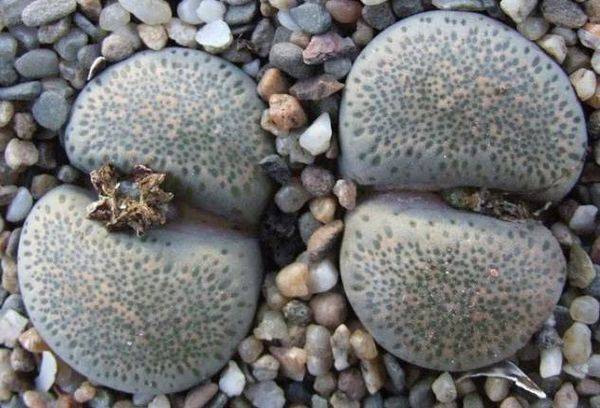
Lithops Volka
Keep in mind that the natural habitat is indeed very scarce. As a result, you do not need any special fertilizing or additional fertilizers. The main thing is to provide heat and sunlight. Many even specifically purchase a lamp that will warm and give the missing ultraviolet.
Finally, watering. It should not be too much. This applies to each species. In the desert, moisture is extremely rare. Rotting is a great danger, which is why it is necessary to comply with all conditions, sometimes it is enough to water it even once a month, in the desert a flower often does not receive even this smallness and it is quite adapted to deprivation.
Lithops is an amazing plant that can decorate a house or a greenhouse. After some time, it will be a few living stones that can captivate the eye. At the same time, with minimal care and effort, you will get a beautiful perennial flower. In the interior of recent times in the fashion of minimalism and luxurious trees are a thing of the past. That is why living stones are becoming more popular, they are relevant for the style of both high-tech and casual. It remains only to choose a large and deep pot and find these rare seeds, and then plunge into the process of growing amazing living stones. They will become the most exotic plant in the house and will always attract attention.
